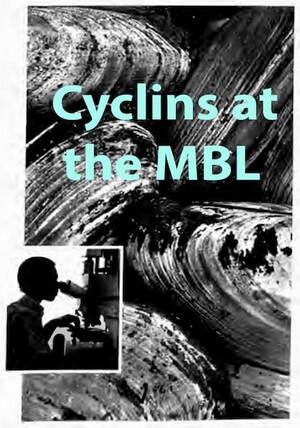Much of the research with cyclins has taken place at the Marine Biological Laboratory in Woods Hole, Massachusetts. In 1979, researcher Joan Ruderman and her lab used clam oocytes (eggs) to study the regulation of development in clams. During the course of that research, Ruderman and her colleagues found that certain proteins would appear and disappear in rapid sequence during the course of development. Continuing to work on determining the action of those proteins, Ruderman spent the next several summers at the MBL researching with a variety of individuals
One of those individuals was Richard Timothy Hunt, an English biochemist. In 1982, Tim Hunt was faculty for the summer Physiology course at the MBL. While teaching that course, Hunt and some of his students identified the proteins that Ruderman had seen in previous years. Hunt named those proteins “cyclins” for his love of bicycling, an appropriate name given the role cyclins play in the cyclical nature of the cell cycle (Nobel Prize, 2001). Hunt, and two others, would go on to win the Nobel Prize in Physiology or Medicine in 2001 for their work with regulators of the cell cycle.
After the identification of cyclin, researchers around the world continued to identify cyclins in many different organisms as well as a variety of cyclins in individual organisms. As the mechanism of cyclins role in the cell cycle became clearer, researchers began to realize that some biological mechanism must regulate the production and destruction of cyclins. Israeli biochemist Avram Hershko came to the MBL in 1991 looking to determine that mechanism using the same clam oocytes Ruderman used in her original research. A few years later, Hershko along with two others, laid out the ubiquitin pathway by which cyclins are degraded during the cell cycle. They went on to win the Nobel Prize in Chemistry in 2004.
What are Cyclins?
- Branden, C. I. (1999). Introduction to Protein Structure. New York: Garland Science. - https://books.google.com/books?id=eUYWBAAAQBAJ&pg=PA107&lpg=PA107&dq=domain+structure+of+cyclins&source=bl&ots=Pz5XNBd3kZ&sig=n2O3Cw0Vr8GmvuV0y-KF6i0PfYw&hl=en&sa=X&ei=BQl3VfOqMu-HsQTY5YOwDQ&ved=0CGIQ6AEwCw#v=onepage&q=domain%20structure%20of%20cyclins&f=false
- Hershko, A. (1999). Mechanisms and regulation of the degradation of cyclin B. Philosophical Transactions of the Royal Society B: Biological Sciences, 354(1389), 1571-1576.
- Nobel Prize, 2001. http://www.nobelprize.org/nobel_prizes/medicine/laureates/2001/hunt-bio.html
Early Work with Cyclins
- Boveri, T. (1902). On multipolar mitosis as a means of analysis of the cell nucleus. Foundations of experimental embryology, 1964, 74-97.
- Franz, S. (2002). http://www.nature.com/celldivision/milestones/full/milestone02.html
- Greaves, S. (2002). http://www.nature.com/celldivision/milestones/full/milestone07.html
- Jackson, P.K. (2008). The Hunt for Cyclin. Cell, 134, 199-202
- MBL History Project. "Joan Ruderman Cyclin Research I." Filmed June 2015. MBL History Project Video, 5:58. Posted June 2015. http://history.archives.mbl.edu/node/16066.
- MBL History Project. "Joan Ruderman Cyclin Research II." Filmed June 2015. MBL History Project Video, 8:55. Posted June 2015. http://history.archives.mbl.edu/content/joan-ruderman-cyclin-research-ii-june-5-2015.
- Mitchell, A. (2002). http://www.nature.com/celldivision/milestones/full/milestone03.html
- Nath, D. (2002). http://www.nature.com/celldivision/milestones/full/milestone06.html
- Patterson, M. (2002). http://www.nature.com/celldivision/milestones/full/milestone05.html
- Rosenthal, E. T., Hunt, T., & Ruderman, J. V. (1980). Selective translation of mRNA controls the pattern of protein synthesis during early development of the surf clam, Spisula solidissima. Cell, 20(2), 487-494.
- Surridge, C. (2002). http://www.nature.com/celldivision/milestones/full/milestone01.html
Tim Hunt and His Discovery of Cyclin
- Evans, T., Rosenthal, E. T., Youngblom, J., Distel, D., & Hunt, T. (1983). Cyclin: a protein specified by maternal mRNA in sea urchin eggs that is destroyed at each cleavage division. Cell, 33(2), 389-396.
- Gerhart, J., Wu, M., & Kirschner, M. (1984). Cell cycle dynamics of an M-phase-specific cytoplasmic factor in Xenopus laevis oocytes and eggs. The Journal of Cell Biology, 98(4), 1247-1255.
- Hunt, T. (2001, December 9). Tim Hunt Nobel Lecture Protein Synthesis, Proteolysis, and Cell Cycle Transitions." Nobelprize.org. Retrieved from: http://www.nobelprize.org/nobel_prizes/medicine/laureates/2001/hunt-lecture.html
- Hunt, T. (2004). The Discovery of Cyclin (I). Cell, S116, S63-S64.
- Jackson, P.K. (2008). The Hunt for Cyclin. Cell, 134, 199-202
- Masui, Yoshio, and Clement L. Markert. "Cytoplasmic control of nuclear behavior during meiotic maturation of frog oocytes." Journal of Experimental Zoology Part A: Ecological Genetics and Physiology 177, no. 2 (1971): 129-145.
- Pulverer, B. (2002). http://www.nature.com/celldivision/milestones/full/milestone12.html
- Swenson, K. I., Farrell, K. M., & Ruderman, J. V. (1986). The clam embryo protein cyclin A induces entry into M phase and the resumption of meiosis in Xenopus oocytes. Cell, 47(6), 861-870.
Cyclins and Genetics
- Ciechanover, A., Finley, D., & Varshavsky, A. (1984). Ubiquitin dependence of selective protein degradation demonstrated in the mammalian cell cycle mutant ts85. Cell, 37(1), 57-66.
- Glotzer, M., Murray, A. W., & Kirschner, M. W. (1991). Cyclin is degraded by the ubiquitin pathway. Nature, 349(6305), 132-138.
- Goldstein, G., Scheid, M., Hammerling, U., Schlesinger, D. H., Niall, H. D., & Boyse, E. A. (1975). Isolation of a polypeptide that has lymphocyte-differentiating properties and is probably represented universally in living cells. Proceedings of the National Academy of Sciences, 72(1), 11-15.
- Gould, K. L. & Nurse, P. (1991). Tyrosine phosphorylation of the fission yeast cdc2+ protein kinase regulates entry into mitosis. Nature 342, 39-45.
- Greenwood, E. (2002). http://www.nature.com/celldivision/milestones/full/milestone09.html
- Hartwell, L. H., Culotti, J., Pringle, J. R., & Reid, B. J. (1974). Genetic control of the cell division cycle in yeast. Science, 183(4120), 46-51.
- Hershko, A. (1991). The ubiquitin pathway for protein degradation. Trends in biochemical sciences, 16, 265-268.
- Hershko, A. (1999). Mechanisms and regulation of the degradation of cyclin B. Philosophical Transactions of the Royal Society B: Biological Sciences, 354(1389), 1571-1576.
- Nature. (2004). A prize for protein degradation. Nature Cell Biology, 6(1011), doi:10.1038/ncb1104-1011.
- Nobel Prize 2001 http://www.nobelprize.org/nobel_prizes/medicine/laureates/2001/
- Nobel Prize 2004 http://www.nobelprize.org/nobel_prizes/chemistry/laureates/2004/ ; http://www.nobelprize.org/nobel_prizes/chemistry/laureates/2004/hershko-bio.html
- Nurse, P. (1975). Genetic control of cell size at cell division in yeast. Nature, 256, 547-551.
- Nurse, P., & Thuriaux, P. (1980). Regulatory genes controlling mitosis in the fission yeast Schizosaccharomyces pombe. Genetics, 96(3), 627-637.
- Patterson, M. (2002). http://www.nature.com/celldivision/milestones/full/milestone05.html
- Russell, P. & Nurse, P. (1986). cdc25+ functions as an inducer in the mitotic control of fission yeast. Cell 45, 145-153.
- Schoenheimer, R. (1942). The Dynamic State of Body Constitutents. Cambridge: Harvard University Press.
- Varshavsky, A. (2006). The early history of the ubiquitin field. Protein science, 15(3), 647-654.

